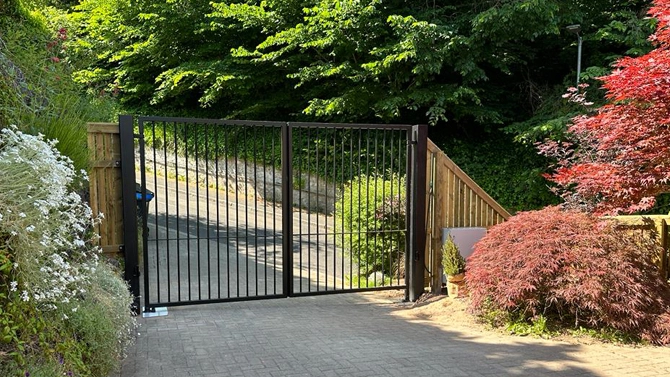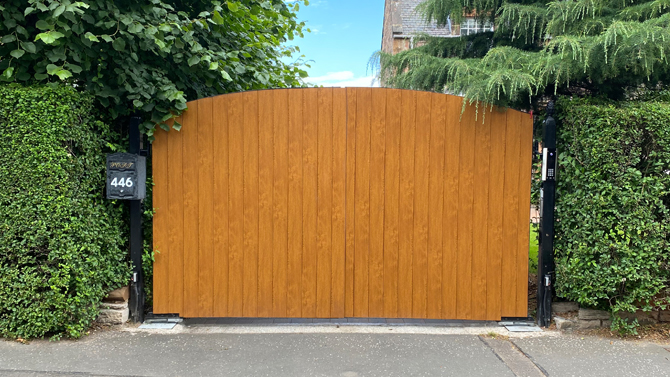We are a Scottish business based in the Borders providing electric gates in Manchester, Edinburgh,…

Electric gate cost
How much does an electric gate cost? Several factors affect the overall price you should expect to pay for an electric gate. The main things to consider include the size, design and purpose of the gate, the structural foundation requirements, automation equipment, safety devices and any access control needs. See below for indicative prices.
- Domestic driveway gate £5000 – £10000
- Industrial driveway gate £10000 – £20000
- Structural concrete foundations £2000 – £5000
- Automation equipment £3000 – £10000
- Safety devices £1000 – £5000
- Access control £500 – £5000
A large amount of electric gates across the UK are unsafe. Organisations such as the Door & Hardware Federation and manufacturers such as Benincà are trying to raise industry standards. Electric gates are a luxury item for domestic properties and often serve a security role in commercial applications. Here, we will identify a few areas for consideration before choosing a gate design, the functions and an installer.
Should I have a swing or sliding gate?
The two most common types of gate in the UK are swing and sliding gates. There are pros and cons to both. Swing gates are hung on hinges, usually to a post, whereas sliding gates are cantilever (not touching the ground) or floor track (use wheels on a track).
Sliding gates use a variety of roller wheels and guide rollers in various positions to keep the gate running smoothly and remain vertical throughout its travel. The rollers are often sold and described as benefitting from ‘lifetime bearings’. Nothing lasts forever, and often replacing sliding gate rollers entails lifting the entire gate, which can be costly later down the line. Rollers that are not suitably maintained increase stress on the motors, resulting in premature failure. There are many blacksmiths across the UK, skilled enough to work with standard swing gates but not competent with sliding gates. This can often mean that maintenance on sliding gates is inadequate. The majority of gate accidents in the UK occur on sliding gates. Sliding gates offer a great degree of security and are fantastic in limited space situations.
Swing gates are found in abundance owing to their ease of manufacturing and simplicity to install. Hinged points are usually easily accessible and therefore easily monitored and maintained. Typically, should any upgrades or adjustments be required, there are usually plenty of blacksmiths willing to oblige. Swing gates are potentially easier to maintain than sliding gates but larger versions require more expensive automation and safety equipment.
Size, design and purpose of an electric gate
A small and lightweight gate will only require a low-power motor to move it. A heavier gate will require a more powerful motor, to overcome the inertia. When wondering ‘how much does an electric gate cost?’, you should expect a small gate, of simple design and light weight to be cheaper than a very large industrial gate, primarily due to the cost of steel and the fabricators time required to make the gate.
Structural foundations for an electric gate
A large, heavy or fully-boarded (can’t see through) gate will possibly require new and substantial structural foundations to support the gate. The larger the gate is, the more we also have to consider external effects such as wind forces. Insufficient foundations will result in a sagging gate and/or posts and could present a serious risk of collapse if not monitored. Concrete foundations should be calculated and the design should be approved by a competent person.
Hydraulic or electro-mechanical automation system for electric gate
A large, heavy or fully-boarded gate will usually require a hydraulic based automation system rather than the cheaper electro-mechanical types. Hydraulic systems are more powerful and offer greater reliability. Electro-mechanical automation systems are perfectly fine for smaller or lightweight gates.
If the installation site is particularly exposed to the elements, such as near to the coast or at high altitude, more powerful hydraulic automation systems may be required to overcome the strong wind forces. Using the incorrect and cheaper electro-mechanical equipment will most likely lead to product failure as it operates outside of its design parameters.
Hydraulic systems tend to be significantly more expensive than electro-mechanical variants and require additional premium parts to function which will further increase the electric gate cost.
Safety devices for electric gates
Many electric gates across the UK are unsafe. Organisations such as the Door & Hardware Federation and manufacturers such as Benincà are trying to raise industry standards. Electric gates are a luxury item for domestic properties and often serve a security role in commercial applications.
As highlighted above, larger and heavier gates require more powerful motors; with more power comes more risk. It is the job of the designer to carry out a risk assessment and identify what hazards do (or may) exist. We can mitigate them by employing ‘Safe Design’ principles or install safety devices.
With smaller lightweight gates it is easier to design-out many of the hazards which exist in an electric gate. Large, heavy or fully-boarded gates are more difficult, usually because the forces exerted by the automation system (motors) are excessive. If intervention is required with the installation of safety devices there are three main solutions which can be used separately or often collectively, wherever appropriate.
Electric gates must meet current safety standards and quite often safety devices are required to meet these high standards. Often, customers choose not to install safety devices as they increase the overall electric gate cost, or wish to add them at a later date.
Safety edges for electric gates
Traditional safety edges come in a range of dimensions but usually resemble a simple black rubber strip, mounted to the areas on a gate where the hazards are identified (usually on the lower edge, leading edge or hinged areas).
The safety edges are actually an electronic device and contain wires inside. When the gate is in motion, if it impacts a pedestrian or vehicle for example; the rubber depresses and the wires inside ‘short’. This is detected by a ‘Safety Edge Controller’, another electronic device, which in turn communicates with the gate control board and immediately stops the gate from moving any further (then it may reverse).
Safety edge solutions have been in use for decades, are reliable and easily maintained. As they are abundant, the prices are reasonable. The downside of safety edges is that the rubber eventually perishes and will require replacing. This can sometimes compromise the aesthetic qualities of a gate.
Laser based safety device for electric gates
Lasers are a modern alternative to traditional safety edge devices and the main manufacturer is BEA, a Belgian company.
The main advantage of a laser safety device is that it is a ‘non-contact’ solution. Laser devices will detect an obstacle prior to impact. This dramatically increases the safety of gate automation systems and provides greater peace of mind where safety is paramount.
Properly designed gates may only require two lasers to be installed. The devices are as large as the palm of your hand and are discretely mounted in the top corners of a gate structure.
The laser is a superior safety solution and the compromise on aesthetic beauty is reduced compared to rubber safety edges. The downside is the cost. Typically, a laser safety solution can cost up to 5x as much as rubber safety edges, increasing the overall electric gate costs.
The lasers have many qualities but often draw unwanted attention to their LED’s, particularly at night time. Vandals may on occasion intentionally damage the lasers. Protective metal shrouds are available to combat this problem.
Access control and security for electric gates
Automation systems are only intended to automatically open or close the gate. It is not a security system. We advise you to consider installing locks if security is a concern.
Locking and security options for electric gates typically include magnetic locks or electric drop bolts.
Magnetic lock for electric gate
Magnetic locks are available in a range of sizes and strengths and can offer a holding force of up to 540kg. Mag locks require less maintenance than an electric drop bolt because they are not mechanical devices. A significant force can overcome the holding force of a magnetic lock.
The system usually includes a magnet, a Z & L bracket (if required), a power supply transformer and a standalone relay for switching on/off.
Drop bolt for electric gate
Electric drop bolts are a mechanical device and usually resemble a motorised piece of metal, driven into the ground. This creates a solid physical barrier to entry.
The system usually includes a drop bolt, a ground plate, a power supply transformer and a standalone relay for switching on/off.
Intercoms and access control for electric gate
There are many ways to operate an electric gate. Depending on the level of security required, access control solutions range from £100 to many thousands of pounds. Generally speaking, the more complicated the access control system or the greater number of users required will increase the electric gate cost. Available solutions include:
- GSM intercom (works like a mobile phone)
- Video intercom
- Standard audio only intercom
- Radio key fobs
- Keypad (code entry)
- ANPR (vehicle number plates)
- 24hr time switch
- Dead man drive (hold button to open/close)
- Proximity cards/fobs (hotel, universities, commercial)


